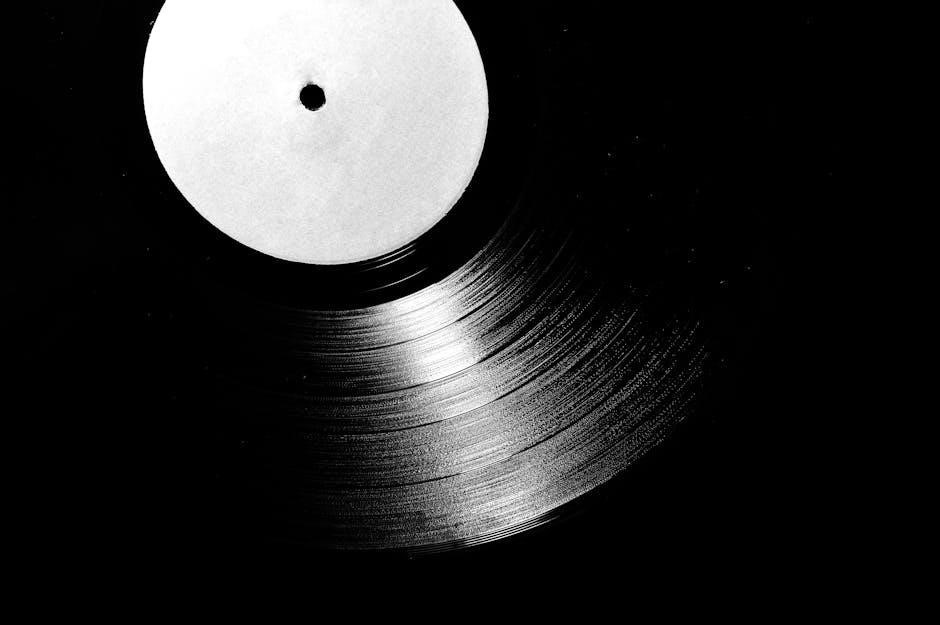
A turntable cartridge is a critical component that translates vinyl grooves into sound‚ ensuring high-quality audio reproduction. Understanding its role and importance enhances your listening experience and setup customization.
What is a Turntable Cartridge?
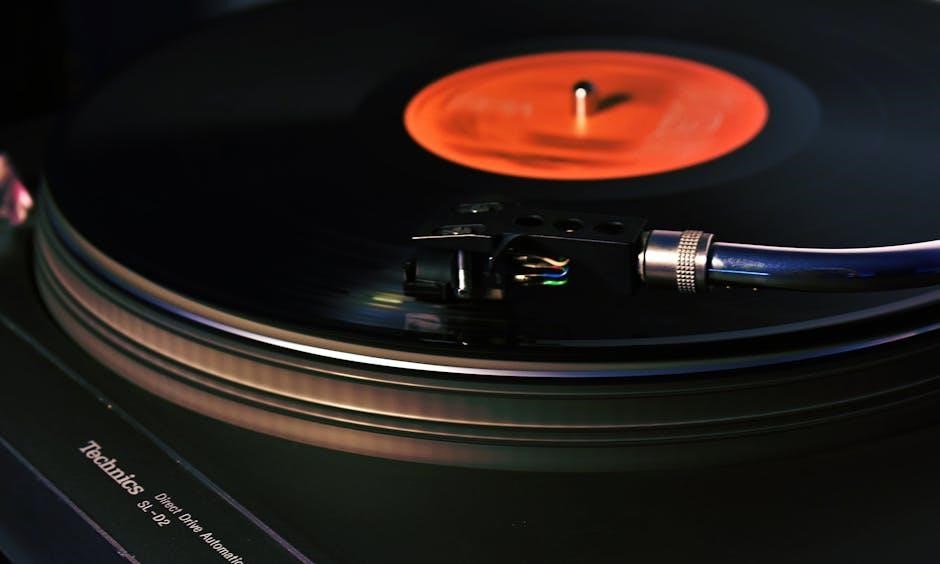
A turntable cartridge‚ also known as a phono cartridge‚ is a device mounted on the tonearm of a record player. It contains a stylus that traces the grooves of a vinyl record‚ converting the mechanical vibrations into electrical signals. These signals are then processed by a phono preamp or amplifier to produce sound. The cartridge is a critical component‚ as its quality directly impacts the accuracy and clarity of audio reproduction. Inside the cartridge‚ a stylus is attached to a cantilever‚ which connects to a coil and magnetic system. As the stylus moves through the record grooves‚ the cantilever vibrates‚ causing the coil to generate electrical signals. This intricate mechanism ensures that the nuances of the music are captured and translated faithfully‚ making the cartridge essential for optimal vinyl playback.
Importance of a High-Quality Cartridge
A high-quality turntable cartridge is essential for achieving optimal sound reproduction and ensuring the longevity of your vinyl records. It directly impacts the clarity‚ depth‚ and accuracy of the audio being played. A premium cartridge reduces distortion‚ minimizes surface noise‚ and captures subtle nuances in the music‚ enhancing the overall listening experience. Additionally‚ it ensures proper tracking force‚ preventing wear and tear on both the stylus and the record grooves. Investing in a superior cartridge not only elevates sound quality but also extends the lifespan of your turntable setup‚ making it a crucial investment for audiophiles and music enthusiasts alike.
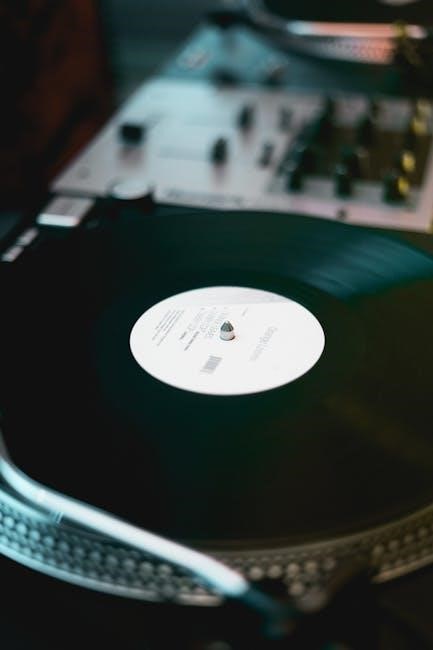
Types of Turntable Cartridges
Turntable cartridges are primarily classified into two types: Moving Magnet (MM) and Moving Coil (MC). Each offers distinct sound quality and compatibility features.
Moving Magnet (MM) Cartridges
Moving Magnet (MM) cartridges are the most common type‚ known for their simplicity and reliability. They feature a fixed magnetic cartridge with a moving stylus‚ inducing voltage through electromagnetic induction. MM cartridges are easy to set up‚ requiring minimal adjustments‚ and are often preferred for entry-level turntables. Their compatibility with built-in phono stages in many amplifiers makes them user-friendly. Additionally‚ MM cartridges typically have replaceable styli‚ reducing long-term maintenance costs. Sound-wise‚ they deliver clear‚ balanced audio‚ making them a popular choice for casual listeners and audiophiles alike. Their durability and ease of use contribute to their widespread popularity in modern and vintage turntable setups.
Moving Coil (MC) Cartridges
Moving Coil (MC) cartridges are renowned for their exceptional sound quality and precision. Unlike MM cartridges‚ MC designs feature a lightweight coil attached to the cantilever‚ which vibrates within a fixed magnetic field to generate electrical signals. This setup allows for more accurate tracking of record grooves‚ resulting in detailed and nuanced audio reproduction. MC cartridges generally require higher gain phono stages and are often paired with step-up transformers to optimize performance. While they are more delicate and require precise setup‚ audiophiles favor them for their ability to capture subtle musical details‚ making them ideal for high-end turntable systems seeking superior fidelity and depth.

How Turntable Cartridges Work
A turntable cartridge converts vinyl grooves into electrical signals through mechanical and magnetic processes‚ capturing sound nuances for accurate audio reproduction and enhanced listening experiences.
The Role of the Stylus
The stylus‚ or needle‚ is the critical component that makes contact with the record groove‚ translating its undulations into electrical signals. Its shape and size significantly impact sound quality and record wear. Proper alignment ensures accurate tracking‚ while excessive force can damage both the stylus and records. Regular cleaning is essential to maintain optimal performance and prevent dust buildup. The stylus’s material‚ such as diamond or sapphire‚ affects durability and fidelity. Over time‚ the stylus may wear out‚ requiring replacement to preserve audio clarity and prevent groove damage. A well-maintained stylus ensures clear‚ distortion-free sound reproduction‚ making it vital for an enjoyable vinyl listening experience.
Understanding the Cantilever
The cantilever is a thin‚ rigid rod in the cartridge that holds the stylus in place‚ acting as a pivot to track the record grooves accurately. Its design and material‚ often aluminum or boron‚ ensure precise movement and durability. Proper alignment of the cantilever is crucial for optimal sound reproduction‚ as misalignment can lead to distorted audio or uneven wear on the stylus. The cantilever’s flexibility allows it to maintain consistent contact with the record‚ absorbing minor vibrations while transferring mechanical energy to the coil. Regular inspection and maintenance of the cantilever are essential to ensure proper tracking force and prevent damage to the cartridge or records. A well-functioning cantilever is vital for achieving clear‚ balanced‚ and immersive sound quality from your vinyl collection.
The Coil and Magnetic System
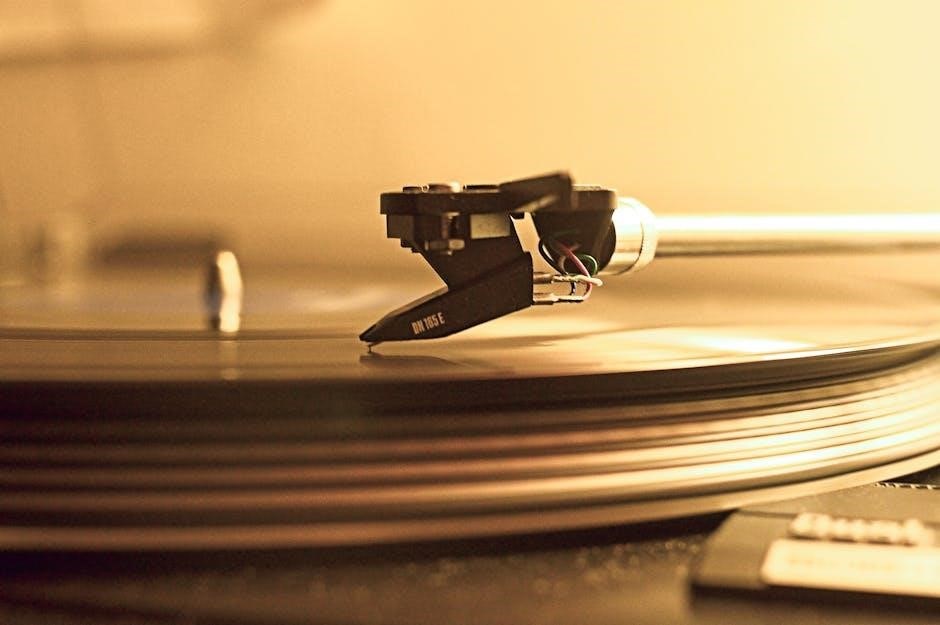
The coil and magnetic system are integral to the cartridge’s operation‚ converting mechanical vibrations from the stylus into electrical signals. The coil‚ typically made of fine copper wire‚ is suspended within a magnetic field. As the stylus tracks the record grooves‚ the cantilever moves‚ causing the coil to oscillate within the magnetic field. These oscillations induce a small electromotive force (EMF) in the coil‚ which corresponds to the audio information encoded in the vinyl. The magnetic system’s strength and alignment play a crucial role in determining the cartridge’s sensitivity and frequency response. High-quality materials and precise engineering ensure accurate signal transfer‚ delivering clear and immersive sound. Proper setup and maintenance of the coil and magnetic system are essential for optimal performance and longevity of the cartridge.
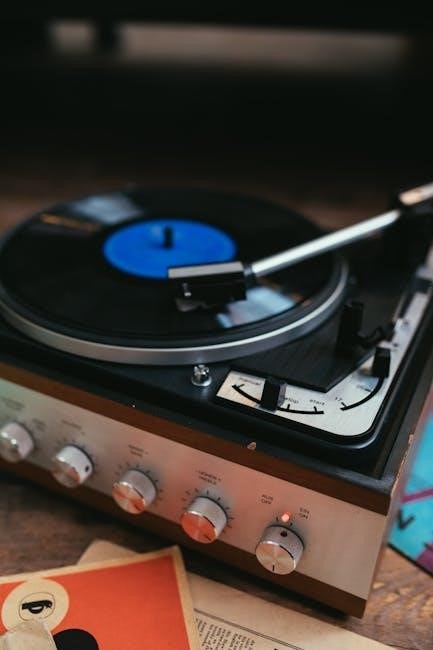
Choosing the Right Cartridge for Your Turntable
Selecting the right cartridge involves considering compatibility with your turntable’s phono preamp and tonearm specs‚ sound quality preferences‚ and cartridge type‚ such as MM or MC‚ to ensure optimal performance and sound reproduction.
Compatibility with Your Turntable
Ensuring your cartridge is compatible with your turntable is crucial for optimal performance. Check the tonearm’s weight and cartridge mounting type‚ such as P-mount or universal mount‚ to match your turntable’s specifications. Additionally‚ verify the phono preamp requirements—moving magnet (MM) or moving coil (MC)—to ensure proper signal transfer. Incorrect pairing can lead to poor sound quality or damage to your equipment. Always refer to your turntable’s manual for specific recommendations or consult with an audio specialist if unsure. Proper alignment and setup are also vital‚ as they affect tracking force and overall sound reproduction. Compatibility ensures your system operates harmoniously‚ delivering the best listening experience.
Considering Sound Quality Preferences
Sound quality preferences play a significant role in choosing the right turntable cartridge. Users seeking warm‚ rich tones may favor moving coil (MC) cartridges‚ while those preferring bright‚ detailed sound often opt for moving magnet (MM) cartridges. The stylus shape‚ such as elliptical or nude‚ also impacts audio reproduction‚ with more precise shapes capturing finer details. Additionally‚ the cartridge’s compliance and tracking force should align with your listening habits—lighter forces for delicate sound‚ heavier for robust playback. Personal musical genres further influence this choice; for example‚ classical may benefit from nuanced detail‚ while rock might demand dynamic energy. Balancing these factors ensures your cartridge enhances your vinyl experience‚ tailored to your unique auditory preferences and musical tastes. Proper alignment and setup are also vital‚ as they affect tracking force and overall sound reproduction. Compatibility ensures your system operates harmoniously‚ delivering the best listening experience.
Cartridge Stylus Shapes and Sizes
The shape and size of a cartridge stylus significantly impact sound quality and tracking ability. Common stylus shapes include spherical‚ elliptical‚ and line-contact designs. Spherical styli‚ often found in budget cartridges‚ offer durability and good tracking but may lack detail in high-frequency reproduction. Elliptical styli‚ with their elongated shape‚ provide better contact with the record groove‚ enhancing sound clarity and reducing wear on both the stylus and vinyl. Line-contact or hyperelliptical styli‚ featuring a narrower and more precise tip‚ excel at tracing intricate groove details‚ delivering superior fidelity and dynamics. Stylus size also matters; smaller‚ finer tips‚ like those in high-end cartridges‚ are better suited for capturing subtle musical nuances and high-frequency sounds; Proper matching of stylus shape and size to your listening preferences ensures optimal performance and preservation of your record collection. Each design offers unique benefits‚ catering to different audiophile needs and budgets.

Installing and Setting Up a Turntable Cartridge
Installing a turntable cartridge involves removing the old one‚ aligning the new cartridge properly‚ and setting the correct tracking force. Special tools like a protractor and gauge ensure accuracy for optimal sound performance and record protection.
Removing the Old Cartridge
Removing the old cartridge is the first step in upgrading your turntable. Start by disconnecting the tonearm wires‚ usually color-coded for easy identification. Gently lift the cartridge from its mount‚ ensuring not to touch the delicate stylus. If the cartridge is secured with screws or clips‚ carefully remove them using the appropriate tools. Once detached‚ store the old cartridge safely to prevent damage. This process allows for a clean installation of the new cartridge‚ ensuring optimal performance and sound quality. Always refer to your turntable’s manual for specific instructions‚ as some models may have unique cartridge mounting systems.
Aligning the Cartridge Properly
Proper cartridge alignment is essential for optimal sound quality and even wear on your records. Use a protractor tool to ensure the cartridge is parallel to the record grooves. Place the protractor on the turntable mat‚ aligning it with the record spindle. Gently adjust the cartridge until it matches the protractor’s guide‚ ensuring proper tracking. Loosen the cartridge screws slightly to allow movement‚ then secure them once aligned. This step prevents distortion and ensures the stylus tracks the groove accurately. Some turntables offer adjustable cartridge mounts for easier alignment. Double-checking alignment periodically ensures consistent performance and extends the life of your cartridge and records. Proper alignment is a critical step in maintaining your turntable’s sound quality and overall functionality.
Adjusting Tracking Force
Adjusting the tracking force ensures the stylus applies the correct pressure on the record‚ optimizing sound quality and preventing damage. Start by setting the counterweight according to the cartridge’s recommended force‚ typically between 1-3 grams. Use a tracking force gauge for accuracy. Gently turn the counterweight until the needle balances perfectly on the gauge. Fine-tune by listening to music‚ ensuring no distortion or skipping occurs. Proper tracking force prevents wear on the stylus and record grooves. Always refer to your cartridge’s manual for specific recommendations. Adjusting this force is crucial for maintaining clear audio reproduction and extending the lifespan of your cartridge and records. Regular checks ensure consistent performance and protect your vinyl collection from unnecessary stress. Proper tracking force is a key factor in achieving optimal sound quality and longevity for your turntable setup.

Maintaining Your Turntable Cartridge
Regular cleaning of the stylus with a soft brush prevents dust buildup‚ ensuring clear sound. Store the cartridge properly when not in use to avoid damage and wear.
Cleaning the Stylus
Cleaning the stylus is essential for maintaining optimal sound quality and prolonging its lifespan. Use a soft‚ dry brush to gently remove dust and debris from the stylus tip. Avoid applying liquid cleaners directly‚ as they can damage the cartridge. Instead‚ use a specialized stylus cleaning solution and a microfiber cloth for more thorough cleaning. Always handle the stylus carefully to prevent accidental bending or damage. Regular maintenance ensures your turntable delivers consistent‚ distortion-free playback.
Storing Records Properly
Properly storing your records is crucial for preserving their quality and ensuring optimal playback. Always store records in an upright position to prevent warping and maintain their shape. Use acid-free‚ non-static sleeves to protect the vinyl from dust‚ scratches‚ and moisture. Avoid exposing records to direct sunlight or extreme temperatures‚ as this can cause warping or damage to the vinyl. Store records in a cool‚ dry environment away from humidity to prevent mold growth. Never stack records loosely‚ as this can lead to scratches or bending. Keep your collection organized and clean to maintain your turntable cartridge’s performance and longevity. Proper storage ensures your records remain in excellent condition for years of enjoyable listening.

Troubleshooting Common Cartridge Issues
Troubleshooting common cartridge issues involves addressing skipping records‚ distortion‚ and worn-out styli. Adjusting tracking force‚ cleaning the stylus‚ and proper alignment often resolve these problems effectively.
Why Your Records Skip or Distort
Records skipping or distorting can be caused by improper tracking force‚ misaligned cartridges‚ or a dirty stylus. Ensure the stylus is clean and the cartridge is properly aligned. Adjusting the tracking force to the recommended level can also resolve these issues. Additionally‚ inspecting the records for warps or scratches and ensuring the turntable is on a stable surface can prevent skips and distortion. Regular maintenance and proper setup are key to optimal sound quality and preventing these common problems.
Signs of Worn-Out Stylus
A worn-out stylus can cause distorted sound‚ increased surface noise‚ and consistent skipping of grooves. Visually‚ the stylus may appear dull‚ rounded‚ or misshapen under magnification. Over time‚ the stylus loses its precision‚ leading to poor tracking and potential record damage. Regular inspection and replacement are crucial to maintain sound quality and protect your records. Replacing the stylus when these signs appear ensures optimal performance and longevity of your turntable setup.

Leave a Reply
You must be logged in to post a comment.